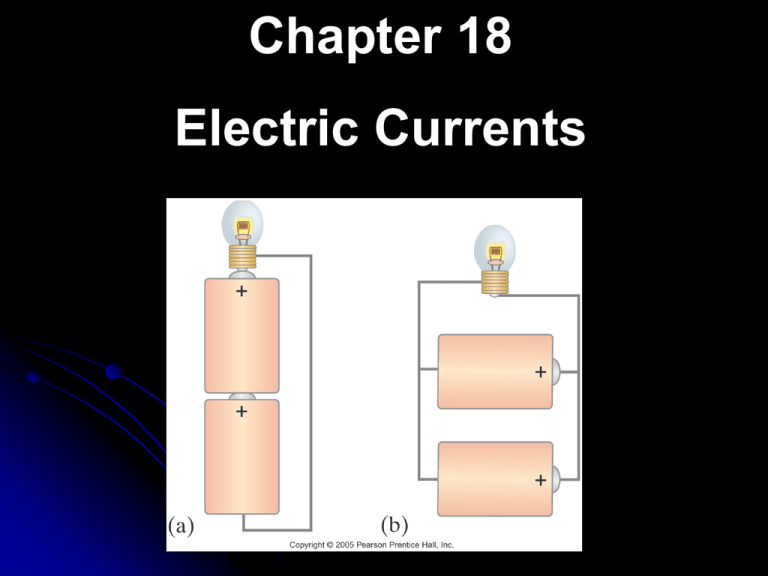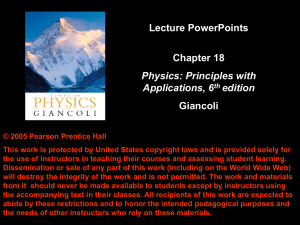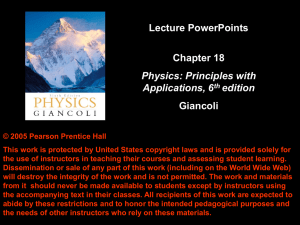Chapter 18 Electric Currents
advertisement

Chapter 18 Electric Currents 18.1 The Electric Battery Volta discovered that electricity could be created if dissimilar metals were connected by a conductive solution called an electrolyte. This is a simple electric cell. 18.1 The Electric Battery A battery transforms chemical energy into electrical energy. Chemical reactions within the cell create a potential difference between the terminals by slowly dissolving them. This potential difference can be maintained even if a current is kept flowing, until one or the other terminal is completely dissolved. 18.1 The Electric Battery Several cells connected together make a battery, although now we refer to a single cell as a battery as well. Figure (b) shows two dry cells connected in series. Lightbulb 18.2 Electric Current Electric current is the rate of flow of charge through a conductor: (18-1) (on formula sheet) Unit of electric current: the ampere, A. 1 A = 1 C/s. 18.2 Electric Current A complete circuit is one where current can flow all the way around. Notice the symbol for a battery and the direction of the current. In an open circuit, no current flows. Schematic Drawing Notice the circuit symbol for the battery above. A steady current of 2.5 A flows in a wire for 4.0 min. How much charge passed through any point in the circuit? How many electrons would this be? 18.2 Electric Current In order for current to flow, there must be a path from one battery terminal, through the circuit, and back to the other battery terminal. Only one of these circuits will work: In (a) it is not a complete circuit. In (b) there is no potential difference to “push” the current. In (c) it would work. 18.2 Electric Current By convention, current is defined as flowing from + to -. Electrons actually flow in the opposite direction, but not all currents consist of electrons. 18.3 Ohm’s Law: Resistance and Resistors Experimentally, it is found that the current in a wire is proportional to the potential difference between its ends: Water analogy 18.3 Ohm’s Law: Resistance and Resistors The ratio of voltage to current is called the resistance: (18-2a) (18-2b) (on formula sheet) 18.3 Ohm’s Law: Resistance and Resistors In many conductors, the resistance is independent of the voltage; this relationship is called Ohm’s law. Materials that do not follow Ohm’s law are called nonohmic. Unit of resistance: the ohm, Ω. 1 Ω = 1 V/A. (a) Is a metal conductor (b) is a semiconductor diode A small flashlight bulb draws 300 mA from its 1.5 V battery. What is the resistance of the bulb? If the voltage dropped to 1.2 V, how would the current change? Current I enters a resistor R as shown below. Is the potential higher at point A or B? Is the current greater at point A or B? This is sometimes called a voltage drop. 18.3 Ohm’s Law: Resistance and Resistors Resistors are used in electric circuits to control the amount of current. Resistors are color-coded to indicate their value and precision. 18.3 Ohm’s Law: Resistance and Resistors Some clarifications: • Batteries maintain a (nearly) constant potential difference; the current varies. •Voltage is applied across a device. •Current passes through a device. • Resistance is a property of a material or device. • Current is not a vector but it does have a direction. • Current and charge do not get used up. Whatever charge goes in one end of a circuit comes out the other end. 18.4 Resistivity The resistance of a wire is directly proportional to its length and inversely proportional to its cross-sectional area: (18-3) (on formula sheet) The constant ρ, the resistivity, is characteristic of the material. 18.4 Resistivity You connect your stereo to remote speakers. If each wire must be 20 m long, what diameter copper wire should you use to keep the resistance less than 0.10 Ω per wire? If the current to each speaker is 4.0 A, what is the voltage drop across each wire? A wire of resistance R is stretched uniformly until it is twice its original length. What happens to its resistance? 18.4 Resistivity For any given material, the resistivity increases with temperature: (18-4) Semiconductors are complex materials, and may have resistivities that decrease with temperature. 18.9 Superconductivity In general, resistivity decreases as temperature decreases. Some materials, however, have resistivity that falls abruptly to zero at a very low temperature, called the critical temperature, TC. 18.9 Superconductivity Experiments have shown that currents, once started, can flow through these materials for years without decreasing even without a potential difference. Critical temperatures are low; for many years no material was found to be superconducting above 23 K. More recently, novel materials have been found to be superconducting below 90 K, and work on higher temperature superconductors is continuing. 18.5 Electric Power Power, as in kinematics, is the energy transformed by a device per unit time: (18-5) 18.5 Electric Power The unit of power is the watt, W. For ohmic devices, we can make the substitutions: (18-6b) (18-6c) Calculate the resistance of a 40-W automobile headlight designed for 12 V. 18.5 Electric Power What you pay for on your electric bill is not power, but energy – the power consumption multiplied by the time. We have been measuring energy in joules, but the electric company measures it in kilowatthours, kWh. An electric heater draws 15.0 A on a 120 V line. How much power does it use and how much does it cost per month (30 days) if it operates 3.0 hr per day and the electric company charges 15.0 cents per kWh? A typical lightning bolt can transfer 109 J of energy across a potential difference of 5 X 107 V during a time interval of about 0.2 s. Estimate the total amount of charge transferred, the current, and the average power. Since 1 kWh = 3.6 X 106 J, how much mass must be lifted against gravity through one meter to do the equivalent amount of work? 18.6 Power in Household Circuits The wires used in homes to carry electricity have very low resistance. However, if the current is high enough, the power will increase and the wires can become hot enough to start a fire. To avoid this, we use fuses or circuit breakers, which disconnect when the current goes above a predetermined value. 18.6 Power in Household Circuits Fuses are one-use items – if they blow, the fuse is destroyed and must be replaced. 18.6 Power in Household Circuits Circuit breakers, which are now much more common in homes than they once were, are switches that will open if the current is too high; they can then be reset. Determine the total current drawn by all of the devices in the parallel circuit on the left. What will happen if the circuit has a 20 A circuit breaker? What happens to the current if one of the devices is removed? Your 1800 W portable electric heater is too far from your desk to warm your feet. Its cord is to short, so you plug it into an extension cord rated at 11 A. Why is this dangerous? 18.7 Alternating Current Current from a battery flows steadily in one direction (direct current, DC). Current from a power plant varies sinusoidally (alternating current, AC). 18.7 Alternating Current The current and voltage both have average values of zero, so we square them, take the average, then take the square root, yielding the root mean square (rms) value. (18-8a) (18-8b) 18.7 Alternating Current VO (peak voltage) = √2 Vrms For example, in the U.S. and Canada, standard line voltage is 120 V. This is Vrms . The peak voltage would be 170 V. Calculate the peak current and the resistance in a 1000 W hair dryer connected to a 120 V line. What happens if it is connected to a 240 V line in Britain? 18.8 Microscopic View of Electric Current Electrons in a conductor have large, random speeds just due to their temperature. When a potential difference is applied, the electrons also acquire an average drift velocity, which is generally considerably smaller than the thermal velocity. 18.10 Electrical Conduction in the Human Nervous System The human nervous system depends on the flow of electric charge. The basic elements of the nervous system are cells called neurons. Neurons have a main cell body, small attachments called dendrites, and a long tail called the axon. 18.10 Electrical Conduction in the Human Nervous System Signals are received by the dendrites, propagated along the axon, and transmitted through a connection called a synapse. 18.10 Electrical Conduction in the Human Nervous System This process depends on there being a dipole layer of charge on the cell membrane, and different concentrations of ions inside and outside the cell. 18.10 Electrical Conduction in the Human Nervous System The action potential propagates along the axon membrane.









